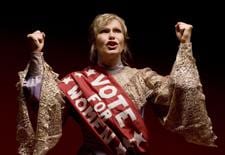In 2007, at the Alberta Playwrights Festival, six Vancouver theatre companies vied for the rights to produce Linda Griffith’s new play, Age of Arousal, a remarkable feat for any script, let alone one that tackles pioneering lesbian feminists in the Victorian era.
Katrina Dunn, artistic director of Touchstone Theatre, had heard about Arousal months earlier and was one of the bidders.
“I got a call when it was still in the very early stages of development from someone who runs a play development company,” Dunn recalls. “She called me because the play had feminist subject matter and I used to run a feminist theatre company. It’s the way [Arousal] portrays women, and the women’s issues it talks about in an interesting and provocative way.”
Dunn recalls the fervour around Arousal from the beginning of the festival.
“There was a lot of excitement,” she says. “[To be] one of six companies eager to produce it in Vancouver —that’s not a common occurrence. That happens very rarely.”
The Arts Club ended up winning the rights, and invited Touchstone to co-produce, with Dunn ultimately taking the reins as director.
A mad scramble to launch a witty drama with queer women characters at its core signifies three things: a need for great writing, a dearth of material representing strong women, and an even bigger black hole for gay female characters on the stage.
Set in 1885, Arousal seems to fill this void. The play centres on Mary, a 60-year-old ex-suffragette who runs a secretarial school for women with her young lover, Rhoda. When three sisters join the school and Mary’s charming cousin Everard, the cad-like playboy, crashes into their lives, Rhoda’s forced to face her political and sexual identity, all under the watchful eye of Victorian-era mores.
On the phone from her home in Toronto, Griffiths acknowledges that it was actually an old copy of George Gissing’s The Odd Women that inspired her to write Arousal. When she set about creating a cast of female characters, she felt drawn to exploring the tangled web of sexuality.
“Everyone in the play is very different sexually, and that was interesting to me,” Griffiths says. “On one-hand, in the play, you have a highly sexed heterosexual woman, and a woman who does not see sexuality as central to who she is. Then you have a bisexual, or somebody who’d had an affair when she was younger, but in our world would have gotten married and had kids and not done it again. There’s a character who’s gay, and a character who is ambiguous. She doesn’t know and will never know, and that is one of the choices she makes in the play. There are many different kinds of sexuality.”
Mary and Rhoda’s sexual relationship is heavily disguised to outsiders as that of mentor and protégé, a typically heterosexual paradigm that Griffiths wanted to turn on its head.
“I was always interested in that relationship anyways,” Griffiths says. “I think there’s always an element of sexuality in that. The buzz often includes a sexual attraction, whether it’s acted on or not. You think of those powerful, intelligent and charismatic men having lovers many years younger than them, but to make this work with women is a harder thing [for some people].”
Laara Sadiq plays Rhoda, perhaps Arousal’s most complicated character, a woman struggling for equality, both with men and in her relationship with Mary.
“Rhoda is conflicted,” Sadiq says. “She has a lot of commitment to her political ideals, and commitment to this woman, Mary, who has been her lover and mentor in many ways, and sort-of business partner. And she wants more, she’s yearning for something. What’s appealing about her is she doesn’t know what that ‘more’ is, what those pieces are that are missing.”
Mary isn’t in any position to reach out and help Rhoda figure it out. Burned by the suffragette movement, she’s determined to make her own way in the world and create financial independence for herself and the women who attend her school.
Susan Hogan, who plays Mary, was encouraged to pursue the role when the play was still in its infancy. Griffiths’ decision to liberally use thought-speak throughout, a device where the characters voice their inner thoughts verbally, caught Hogan’s attention.
Arousal is “not an easy read,” Hogan says. “It’s cluttered and it’s dirty, but that’s the way we are as human beings. We’re not clean and straight-forward and obvious in our choices.”
The feminist theme that originally attracted Dunn engaged Hogan as well, who was struck by the curious echoes that continue to surface now, more than 120 years after the play is set.
“I have a daughter and a granddaughter,” Hogan says. “These issues [feminism, gay rights, equality] continue to be so vitally important, and must continue to be — whether it’s the abortion issue or the right to vote or the right to marry.”
Arousal’s timeliness may be the driving force behind its success, but its Vancouver debut signifies something greater: lesbian stories, women’s stories, are finally being welcomed out of the closet.
“Touchstone has been producing work by a number of gay playwrights over the years,” Dunn says. “Usually that’s male content, and that’s great, there’s a huge audience for that and it’s great to tell those stories. But the lesbian stories come up way less often, so I was very excited to look into that subject matter and try to reach that audience.
“I don’t think they see their stories told hardly at all. This is a large production in a very established theatre, which isn’t how we’ve presented this subject matter in the past, but it’s great to bring the gay audience into that fold and show them their stories are being told on the big stage now.”

 Why you can trust Xtra
Why you can trust Xtra


